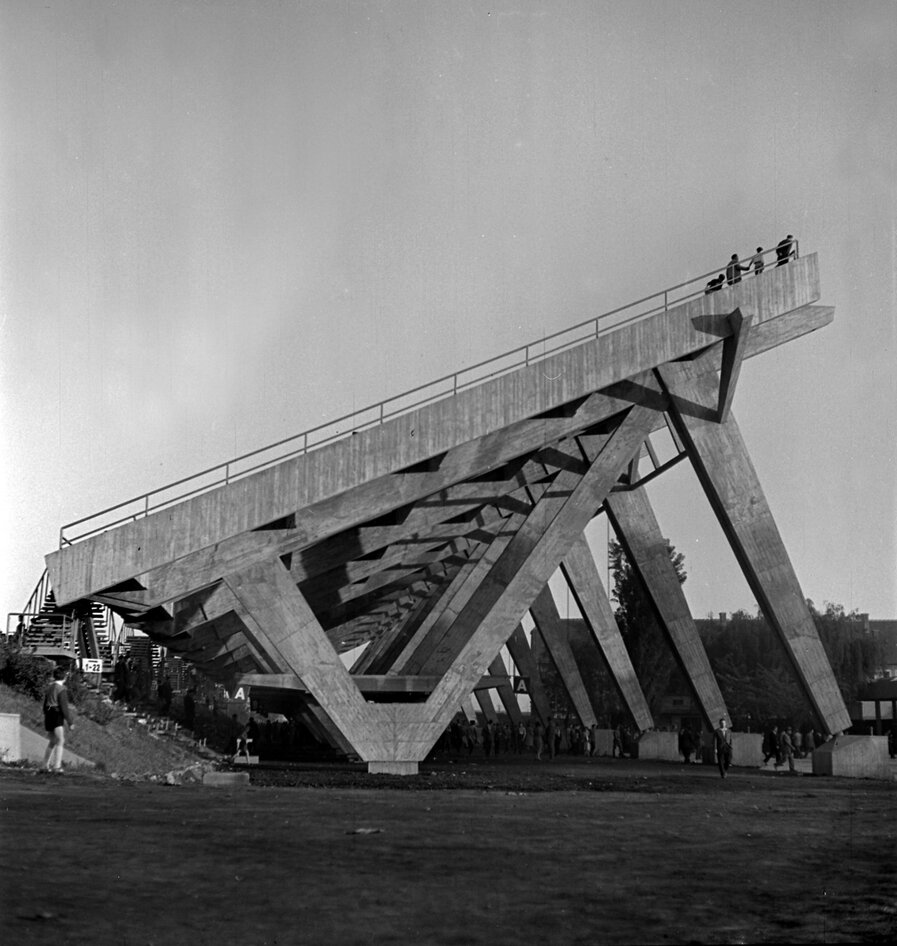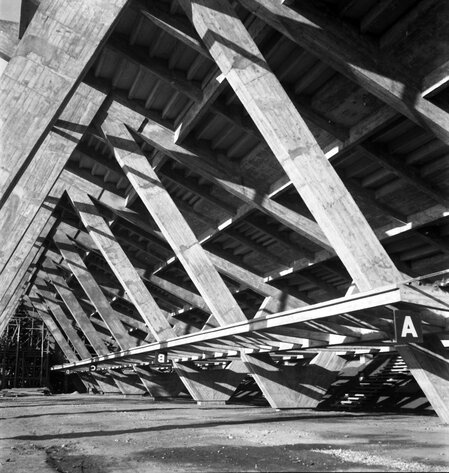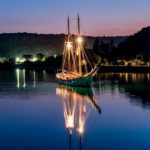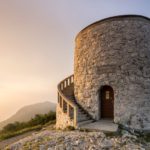Maksimir Stadium is an exceptional example of sports architecture because it is situated on a relatively narrow plot along Maksimirska Cesta, it opens up to an extraordinary view of Maksimir Park and Nature Park Medvednica in the distance, and judging from the complex and its details, it exhibits a high quality of design.
The architectural legacy of one of the most influential Croatian architects, Vladimir Turina, creator of Maksimir Stadium (1946 – 1964), still represents a pillar of society and is an inspiration to people because his language of architecture is understandable, true, simple, emotional and powerful, and is as such a part of the Zagreb City Museum treasures.

Professor Turina saw architecture decades in advance. Immediately after the Second World War, he devoted himself intensively to the theme of sports architecture, especially stadium and swimming pool design. After becoming a highly reputed architect worldwide, he was recognized as an expert in the field of sports architecture and was asked to develop the conceptual design for the Olympic Stadium in Tehran with a capacity of 120,000 (1967-1968), while his principal projects (Maksimir Stadium) were presented and published in both Croatian and foreign journals, as independent publications, and in the catalogs of Olympic and international exhibitions of sports architecture. Furthermore, he won numerous awards and recognitions in this area of study in Croatia and abroad. As a professor of architectural design, he raised generations of students at what was at the time the only school of architecture in the country, the Faculty of Architecture, University of Zagreb.

The aim of the exhibition is to provide a historical cross-section, to contextualize and emphasize the importance of the Stadium and the surrounding area as an inspiring environment, to affirm it as the source of sports in Zagreb, affirm its architecture and urbanism, the connection with the club, the fans, the people, the city and Maksimir Park [for example, the management of FC Barcelona points out: “what constitutes the value and uniqueness of Barca’s real estate is precisely its location”, Camp Nou].
Stadiums and their “spatial enormity” entail common, urban identity, emotional factors – the mythical Maksimir (memory of the place – the spirituality of the phenomenon). GNK Dinamo is a sports symbol of Zagreb, but also much more than that because football is a universal value in the world today. Dinamo is a record holder in the history of the World Cup finals in terms of the number of its former and active players.
The exhibition is the result of many years of scholarly research (based on the author’s doctoral thesis, taking into account the scientific contributions of her associates and colleagues in the field of sports architecture, and beyond), and its content gradually created its final appearance and atmosphere. Since Maksimir Stadium is not only an architectural complex, but also a dynamic space for work, sports competitions, supporters, socializing, musical spectacles, the exhibition material is broader in content and production, it is scientifically interpreted, and at the same time does not aim to be conventional, but dynamic and fun.

As is evident from the title of the exhibition, the two main themes are closely connected: Maksimir Stadium in history and today, with an emphasis on the projects by architect Vladimir Turina, and especially his sports architecture projects. Through several sub-themes, the individual sections of the two main themes are placed in spatial and temporal contexts.
The exhibition consists of two groups of items: original drawings, photographs, and publications of the planning and construction stages of Maksimir Stadium (1945-1969) and other buildings which belong to sports architecture designed by Vladimir Turina (1941-1968), with the addition of various other items that explain the material. Those are the items that belonged to Prof. Turina, such as GNK Dinamo trophies, plastic seats from the stands, pieces of turf, free-kick mannequins, projections of possible fixtures, posters, and catalogs of two big concerts, by David Bowie and U2…
Models of the cross-sections of the West and East stands were made especially for the exhibition, and a model of the entire stadium was borrowed from the Faculty of Architecture for the occasion. The small statue of baby Jesus is here to remind us of Antunovac Monastery, which has since 1947 been home to the Institute for Mentally Handicapped Children (originally an orphanage for “abandoned and neglected children, for the poor and the sick”, managed by the Sisters Servants of the Holy Child Jesus), located right at the site of the foundations of the West Stand until it was demolished, and the Sisters moved to Nova Ves. It is interesting to see the project of the Central Stadium (1945/1946), which was planned for the central part of today’s entire sports complex at Svetice.
We can recognize the gentle line of the stands of Turina’s Olympic Stadium Banjica, Belgrade (1st prize, unrealized, 1947) in the City Stadium in Poljud by Boris Magaš, Turin’s assistant and associate on several projects, including the East Stand of the Maksimir Stadium. The exhibition setup provides each displayed item with appropriate space and place, and the words also represent a construction layer of space and are a segment equal to the rest of the material. The imitation of the TUNNEL through which the team enters the football field (Stadium’s South Stand), accompanied by an original score from the film The Warriors (1979, Walter Hill), used as Dinamo’s anthem, is an important element of the exhibition which corresponds to the “entrance procession” to the exhibition. Furthermore, there are the murals (graffiti), which we can also observe, and which are part of the urban design of the city, and also much more than that: “YOU MAKE ME HAPPY WHEN LIFE IS SAD” (K. Vojnović 28). One of the recent Bad Blue Boys murals is dedicated to the town of VUKOVAR (underpass at Čulinečka Street, Dubrava).

CURRENT CONDITION OF MAKSIMIR STADIUM / WELCOME TO MAKSIMIR STADIUM – HOME OF GNK DINAMO
It is quite natural that the new time sets new standards and desires – functional, technological, utilitarian. There are issues with the financing of sports facilities because the capacity of the stadium must be increased, and at the same time, it must be adapted to the new rules of the world football organizations (FIFA, UEFA). Stadiums are in a process of change due to the new dynamics of the game. In designing (new buildings) or reconstruction/revitalization of sports facilities, the initial criteria are financial interests (poly-functional / multifunctional facilities enable the dynamics of stadium life regardless of its primary function), security (terrorism – screening, corridors for special forces between spectators and playgrounds, inter-zones, which we did not have before), as well as speed and evacuation routes (in traffic) – standards which every stadium has to meet if it wants to be a venue for international competitions.


As opposed to the original highly aesthetic conception of the stadium (following world events), which at the time of construction met the criteria of what was then considered a modern sports facility, the situation today is significantly different. Since the end of the 20th century, there have been numerous studies on the reconstruction of the stadium, so far only partially performed. Despite some constructional interventions, Turina’s approach to the “open landscape arena” has not yet been completely compromised. After performing a detailed strategic analysis of the current condition and scope of the investment, the original stands in the west and east, which are an integral part of the whole, should be preserved during earthquake remediation and further works on the revitalization of the stadium so as to prevent future degradation, with the aim of defining the original qualities of valuable cultural heritage. Without having an imperative approach, it is important to point out that it does not make sense to demolish a functional stadium in which large financial resources have so far been invested. Even if a more radical intervention is made, it would be important to preserve the segments of its original condition.

Clearly, such decisions should be preceded by a complex cost-benefit analysis concerning the possibility of long-term sustainability. In addition to primary (economic) factors, this kind of analysis would also have to include secondary factors: location memory and the best solution for it, taking into consideration the product of the relationships with the environment, how it would affect people, benefits for the city, costs of the completion of reconstruction/upgrade, new constructions/demolition, the possibility of conversion into another kind of facility, and others. Maksimir Stadium deserves to be thought of seriously and responsibly.
Through its relationship with the Sports and Recreation Centre Svetice, the forest, as well as parts of nothingness – emptiness, with a new large swimming pool which is directly connected to the stadium due to its glass enclosure, with all the emotional factors connected to the club and the location, Maksimir Stadium retained its suggestiveness and the power of space, without losing the “PRIMARY RELATIONSHIP SPACE – A HUMAN BEING. OLD SETTINGS. SPONTANEOUS, HARMONIC, HUMAN”.
(V. Turina, 1963c)
Author: Hela Vukadin Doronjga Ph. D. / mgz.hr




